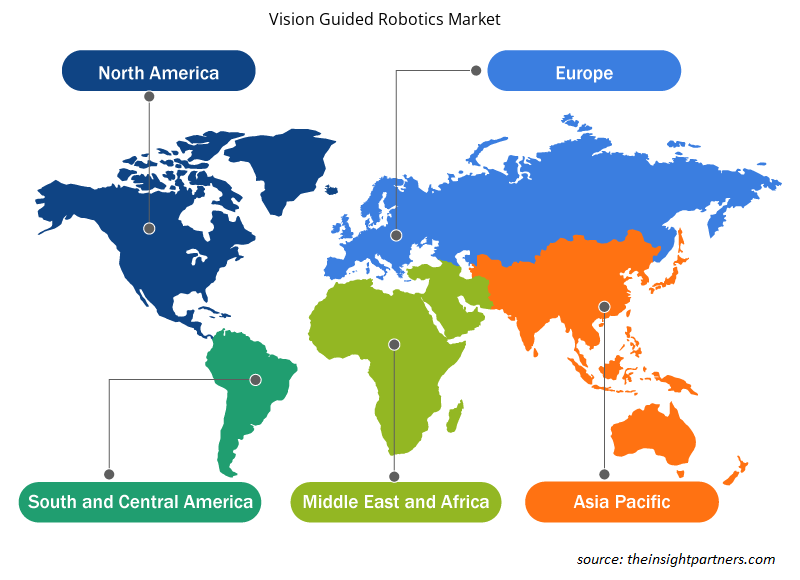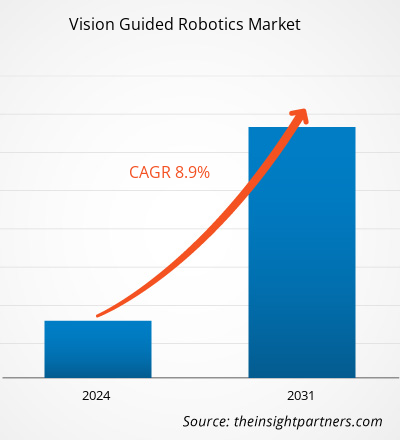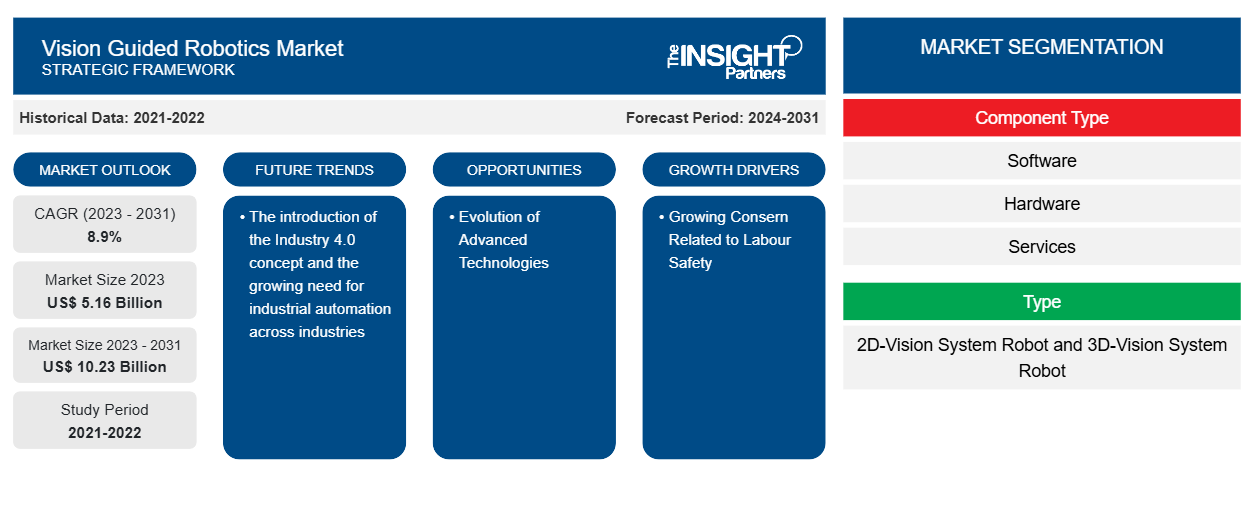비전 가이드 로봇 시장 규모는 2023년 51억 6천만 달러에서 2031년까지 102억 3천만 달러에 도달할 것으로 예상됩니다. 이 시장은 2023~2031년에 8.9%의 CAGR을 기록할 것으로 예상됩니다. 산업 4.0 개념의 도입과 산업 전반에 걸친 산업 자동화에 대한 증가하는 요구는 비전 가이드 로봇 시장 추세의 핵심으로 남을 가능성이 높습니다.
비전 가이드 로봇 시장 분석
비전 가이드 로봇 시장은 노동 안전에 대한 우려가 커지고, 산업계에서 품질 검사 및 제어에 대한 수요가 증가하고, 중소기업에서 비전 가이드 로봇을 채택하는 것이 늘어나면서 빠른 속도로 성장하고 있습니다. 시장은 협업 제조 환경에서 협업 로봇의 사용이 증가함에 따라 꾸준히 확대되고 있습니다. 게다가 첨단 기술의 진화와 머신 비전 기술의 발전은 시장 성장에 수익성 있는 기회를 제공하고 있습니다.
비전 가이드 로봇 시장 개요
비전 가이드 로봇은 컴퓨터 비전 알고리즘과 카메라를 사용하여 로봇이 시각적 인식과 해석이 필요한 작업을 수행할 수 있도록 하는 로봇 시스템입니다. 비전 가이드 로봇의 기본 아이디어는 로봇이 주변 환경을 보고 이해할 수 있는 능력을 부여하여 탐색하고, 사물과 상호 작용하고, 작업을 보다 정확하고 효율적으로 수행할 수 있도록 하는 것입니다. 비전 가이드 로봇은 종종 고해상도 카메라, 최신 이미지 처리 및 머신 러닝 알고리즘을 사용하여 시각 데이터를 평가하고 이를 기반으로 판단을 내립니다. 비전 가이드 로봇은 일반적으로 픽앤플레이스 활동, 조립 및 검사, 포장 및 품질 관리에 사용됩니다. 자동차, 항공우주 및 방위, 식품 및 음료, 전기 및 전자, 의료 및 제약, 금속 가공 등 수많은 산업에서 비전 가이드 로봇의 채택이 증가하면서 시장이 주도되고 있습니다.
귀하의 요구 사항에 맞게 이 보고서를 사용자 정의하세요
이 보고서의 일부 또는 국가 수준 분석, Excel 데이터 팩을 포함하여 모든 보고서에 대한 사용자 정의를 무료로 받을 수 있으며 신생 기업 및 대학을 위한 훌륭한 혜택과 할인 혜택을 이용할 수 있습니다.
-
이 보고서의 주요 시장 동향을 알아보세요.이 무료 샘플에는 시장 동향부터 추정 및 예측까지 다양한 데이터 분석이 포함됩니다.
비전 가이드 로봇 시장 동인 및 기회
노동 안전과 관련된 우려가 커지면서 시장이 성장하고 있습니다.
국제 노동 안전 요구 사항이 더욱 엄격해짐에 따라 전 세계 산업은 위험한 지역에서 인간 근로자를 대체하여 로봇 도입을 선호도로 바꾸고 있습니다. 로봇은 인간에게 해롭고 안전하지 않은 작업을 수행할 수 있으므로 혹독한 지형에서 작업하고 유해 물질을 관리하는 것을 포함하여 위험한 지역에서 수요가 증가합니다. 산업은 위험을 줄일 수 있으며, 특정 위험한 환경에서 로봇을 사용하여 발생하는 직장 사고 수는 예측 기간 동안 비전 가이드 로봇 시장을 촉진하고 있습니다.
첨단 기술의 진화 - 비전 가이드 로봇 시장의 기회
새로운 기술의 도입으로 시장에서 보다 효과적이고 효율적인 로봇이 개발되었습니다. 이러한 기술적으로 진보된 로봇은 더 높은 정확도와 정밀도로 작업을 수행할 수 있어 비용이 절감됩니다. 따라서 예측 기간 동안 시장 성장에 기회가 생깁니다.
기술의 발전으로 로봇 시스템이 더욱 컴팩트하고 모듈화되어 더 높은 품질, 더 다재다능한 로봇이 탄생했습니다. 증강 및 모듈형 로봇의 사용이 증가함에 따라 가까운 미래에 시장에 상당한 성장 기회가 창출되고 있습니다.
비전 가이드 로봇 시장 보고서 세분화 분석
비전 가이드 로봇 시장 분석에서 도출된 주요 세그먼트는 구성 요소 유형, 유형 및 산업 분야입니다.
- 구성 요소 유형에 따라 비전 가이드 로봇 시장은 소프트웨어, 하드웨어, 서비스로 구분됩니다. 하드웨어 세그먼트는 2023년에 더 큰 시장 점유율을 차지했습니다.
- 유형 기준으로 시장은 2D 비전 시스템 로봇과 3D 비전 시스템 로봇으로 세분화됩니다. 3D 비전 시스템 로봇 세그먼트는 2023년에 더 큰 시장 점유율을 차지했습니다.
- 산업 수직 측면에서 시장은 자동차, 항공우주 및 방위, 식품 및 음료, 의료 및 제약, 전기 및 전자, 금속 가공 및 기타로 분류됩니다. 자동차 부문은 2023년에 더 큰 시장 점유율을 차지했습니다.
지역별 비전 가이드 로봇 시장 점유율 분석
비전 가이드 로봇 시장 보고서의 지리적 범위는 주로 북미, 아시아 태평양, 유럽, 중동 및 아프리카, 남미/남중미의 5개 지역으로 나뉩니다.
수익 측면에서 아시아 태평양 지역은 신기술과 대량의 제조 역량으로 인해 비전 가이드 로봇 시장 점유율이 가장 높았습니다. 또한, Industry 4.0 개념의 확대된 배포와 기업의 제조 시설 설립 투자 증가로 인해 예측 기간 내내 수요가 증가할 것으로 예상됩니다.
비전 가이드 로봇 시장 뉴스 및 최근 개발
비전 가이드 로봇 시장은 1차 및 2차 연구 이후의 질적, 양적 데이터를 수집하여 평가합니다. 여기에는 중요한 기업 간행물, 협회 데이터 및 데이터베이스가 포함됩니다. 다음은 비전 가이드 로봇 및 전략 시장의 개발 목록입니다.
- 2023년 3월, Smart Vision Lights는 비전 가이드 로봇의 최근 진화를 살펴보고 새로운 자동화 솔루션을 찾는 기업을 안내하는 Quality Magazine의 웨비나를 공동 후원합니다. 이 웨비나는 시장에 관계없이 회사, 품질, 플랜트 관리 및 엔지니어링과 운영을 포함하여 비전 가이드 로봇 기술에 관심이 있는 모든 사람에게 서비스를 제공합니다. (출처: Smart Vision Lights, 보도자료, 2023)
비전 가이드 로봇 시장 보고서 범위 및 제공물
"비전 가이드 로봇 시장 규모 및 예측(2023-2031)" 보고서는 아래 영역을 포괄하는 시장에 대한 자세한 분석을 제공합니다.
- 범위에 포함된 모든 주요 시장 세그먼트에 대한 글로벌, 지역 및 국가 수준의 시장 규모 및 예측
- 동인, 제약 및 주요 기회와 같은 시장 역학
- 주요 미래 트렌드
- 자세한 PEST/포터의 5가지 힘과 SWOT 분석
- 주요 시장 동향, 주요 업체, 규정 및 최근 시장 동향을 포괄하는 글로벌 및 지역 시장 분석
- 시장 집중도, 히트맵 분석, 유명 기업 및 최근 개발 사항을 포함하는 산업 환경 및 경쟁 분석
- 자세한 회사 프로필
보고 범위
비전 가이드 로봇 시장 지역 통찰력
Insight Partners의 분석가들은 예측 기간 동안 비전 가이드 로봇 시장에 영향을 미치는 지역적 추세와 요인을 철저히 설명했습니다. 이 섹션에서는 북미, 유럽, 아시아 태평양, 중동 및 아프리카, 남미 및 중미의 비전 가이드 로봇 시장 세그먼트와 지리에 대해서도 설명합니다.

- 비전 가이드 로봇 시장에 대한 지역별 데이터 얻기
비전 가이드 로봇 시장 보고서 범위
| 보고서 속성 | 세부 |
|---|---|
| 2023년 시장 규모 | 51억 6천만 달러 |
| 2031년까지 시장 규모 | 102억 3천만 달러 |
| 글로벌 CAGR (2023-2031) | 8.9% |
| 역사적 데이터 | 2021-2022 |
| 예측 기간 | 2024-2031 |
| 다루는 세그먼트 |
구성 요소 유형별
|
| 포함된 지역 및 국가 |
북아메리카
|
| 시장 선도 기업 및 주요 회사 프로필 |
|
비전 가이드 로봇 시장 참여자 밀도: 비즈니스 역학에 미치는 영향 이해
Vision Guided Robotics Market 시장은 소비자 선호도의 변화, 기술 발전, 제품의 이점에 대한 인식 증가와 같은 요인으로 인해 최종 사용자 수요가 증가함에 따라 빠르게 성장하고 있습니다. 수요가 증가함에 따라 기업은 제품을 확장하고, 소비자의 요구를 충족하기 위해 혁신하고, 새로운 트렌드를 활용하여 시장 성장을 더욱 촉진하고 있습니다.
시장 참여자 밀도는 특정 시장이나 산업 내에서 운영되는 회사나 기업의 분포를 말합니다. 주어진 시장 공간에 얼마나 많은 경쟁자(시장 참여자)가 존재하는지 그 규모나 전체 시장 가치에 비해 나타냅니다.
비전 가이드 로봇 시장에서 운영되는 주요 회사는 다음과 같습니다.
- ABB 유한회사
- 바슬러 AG
- 코그넥스
- 덴소 주식회사
- 파누크 주식회사
- ISRA 비전
면책 조항 : 위에 나열된 회사는 어떤 특별한 순서에 따라 순위가 매겨지지 않았습니다.

- Vision Guided Robotics Market의 주요 기업 개요를 알아보세요
- 과거 분석(2년), 기준 연도, CAGR을 포함한 예측(7년)
- PEST 및 SWOT 분석
- 시장 규모 가치/거래량 - 글로벌, 지역, 국가
- 산업 및 경쟁 환경
- Excel 데이터세트
최근 보고서
사용 후기
구매 이유
- 정보에 기반한 의사 결정
- 시장 역학 이해
- 경쟁 분석
- 고객 인사이트
- 시장 예측
- 위험 완화
- 전략 기획
- 투자 타당성 분석
- 신흥 시장 파악
- 마케팅 전략 강화
- 운영 효율성 향상
- 규제 동향에 발맞춰 대응























 무료 샘플 받기 - 비전 가이드 로봇 시장
무료 샘플 받기 - 비전 가이드 로봇 시장